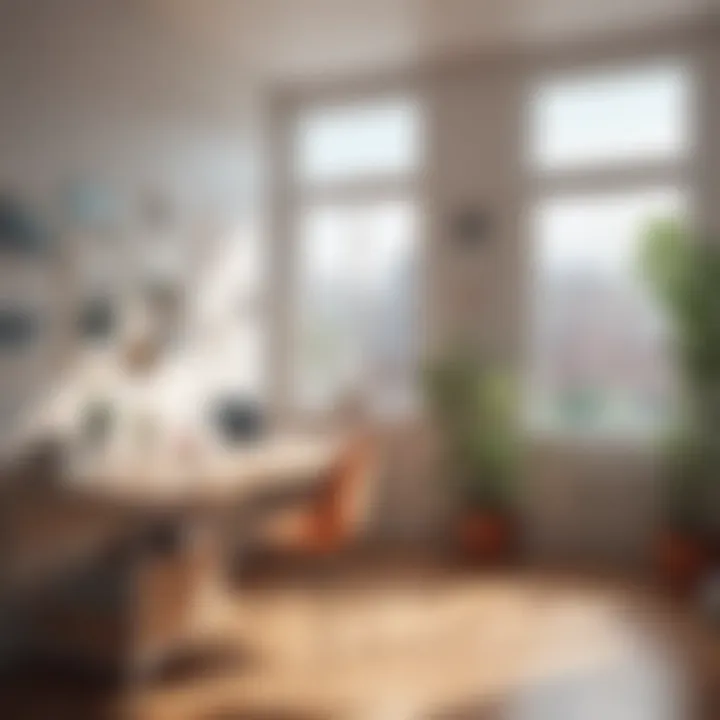The Art of Doing Nothing: A Thoughtful Analysis


Intro
In a world that seems constantly on the move, the concept of doing nothing often feels somewhat foreign. This notion, which many dismiss as unproductive or even frivolous, holds significant value. By exploring the interconnected themes presented in the book about idleness, readers can begin to appreciate not only the philosophical ideas surrounding it but also the profound implications for our mental well-being and overall quality of life.
As we plunge into this narrative, we will uncover layers of thought that challenge the prevailing notions of productivity that dominate modern society. Doing nothing is far from being merely a lazy act; it's a deliberate choice to step back, reflect, and regain harmony with one's thoughts and environment.
Book Categories
Fiction and Literature
Though this book may not be fictional in the traditional sense, it weaves anecdotal stories and philosophical musings into a tapestry that resonates deeply with readers. Learning to embrace stillness becomes a recurring theme, and as such, readers are encouraged to view their day-to-day lives through a different lens. Through its narrative architecture, the text evokes both empathy and contemplation, causing one to ponder over their relationship with time.
Self-Help and Personal Development
Here, the book truly shines. It serves as a guide for anyone feeling the weight of societal expectations. The lessons it imparts may come across as simple, yet their impact can be transformative. Readers are urged to reconsider how they allocate their time, fostering a new outlook that values mindfulness over mindless busyness. The text pushes readers to explore their inner drives, nudging them toward personal growth through self-reflection.
Key Insights and Takeaways
This examination of doing nothing offers several key insights:
- Mindfulness Matters: Embracing idleness allows individuals to practice mindfulness, ultimately enhancing mental clarity and emotional resilience.
- Critique of Productivity: Society’s obsession with constant productivity often leads to burnout. The book challenges this norm, suggesting a more balanced approach.
- Cherishing Leisure: Leisure time should be viewed as a necessity rather than a luxury; this shift can lead to more profound self-discovery and joy.
- Connection with Nature: Taking the time to step back and connect with the natural world often brings a sense of peace and belonging.
"The art of doing nothing is not about laziness; it's about creating space for growth by allowing the mind to simply exist without the pressures of the outside world."
How to Apply the Lessons
Integrating the lessons from this exploration into daily life may be straightforward yet requires intent:
- Schedule Downtime: Carve out moments in your day dedicated solely to relaxation. Start small—perhaps five minutes of silence.
- Practice Mindfulness: Engage in mindfulness techniques, such as meditation or deep breathing exercises, to uncover the power of being present.
- Explore Nature: Spend more time outdoors, with no agenda; let the environment inspire you.
- Dare to Disconnect: Try an hour or a day of digital detox. This can help break the cycle of constant stimulation that often leads to stress.
By considering these elements, readers can begin to transform their understanding of productivity and personal fulfillment, truly grasping the art of doing nothing.
As we dig further into the richness of the book, it's essential to reflect on how these lessons can be embraced in a world that has long glorified busyness.
Defining the Concept of Doing Nothing
In our relentless pursuit of success, the concept of doing nothing often takes a backseat, dismissed as unproductive or lazy. However, understanding what doing nothing truly means is essential to appreciating its value. This exploration of doing nothing sheds light on the significance of idleness in our fast-paced world. It prompts us to question the cultural obsession with constant productivity, offering a fresh perspective on well-being and mental health.
The beauty of defining this notion lies in its inherent simplicity, yet its implications are profound. Doing nothing is not merely the absence of action, but a conscious choice—an opportunity to engage with one’s thoughts, recharge emotionally, and foster creativity. Embracing idleness introduces space for reflection and self-discovery, which are often sidelines in our busy lives. Through the lens of this article, we highlight several aspects pertinent to the topic:
- Personal Reflection: Understanding what idleness means can lead to better self-awareness.
- Enhanced Creativity: Moments of stillness can ignite the mind’s spark.
- Mental Clarity: Reducing the noise of daily chaos helps in forming clearer thoughts.
- Reevaluating Productivity: Learning to regard leisure as a necessary complement to productive activity.
Historical Perspectives
Throughout history, various philosophers and writers have recognized the importance of idleness. For example, the ancient Romans had a word—otium—which encompassed the idea of leisure as a state of mind conducive to creativity and relaxation. The Romans believed that idleness was an essential counterbalance to labor, allowing time for introspection and intellectual pursuits.
In the 19th century, thinkers like Henry David Thoreau championed simplicity and reflection in nature, advocating for quieter lives. His time spent in a cabin near Walden Pond led to insights that remain relevant today—finding peace away from societal pressures.
Cultural Interpretations
Across different cultures, doing nothing holds various meanings. In many Eastern traditions, such as Buddhism, the practice of mindfulness and meditation embraces the idea of consciously stepping back from the rush of daily life. This practice highlights how stillness can lead to profound insights and a richer existence. In contrast, Western societies often equate idleness with laziness, perpetuating a cycle of guilt surrounding the act of doing nothing.
The cultural tension surrounding idleness is striking. It calls for a redefinition—not just viewing it as an end, but as a process that nurtures the mind. More recently, movements advocating work-life balance and mental well-being are gaining traction, hinting at a societal shift towards recognizing the merit of doing nothing.
In summary, defining the concept of doing nothing requires a historical and cultural lens. It posits that idleness can inspire reflection, creativity, and mental clarity, setting the stage for a deeper exploration of its implications in modern life.
Philosophical Underpinnings
The study of idleness isn't merely a matter of leisure; it’s steeped in philosophical discourse that invites deep reflection. In the world we inhabit, grappling with productivity appears to be the acceptable norm, yet there remains a compelling counter-narrative that champions doing nothing as a profound existential statement. By examining these philosophical underpinnings, readers can uncover layers of meaning that illuminate not just the practice of idleness but its essential place in our lives.
Conceptual Frameworks
At its core, the concept of doing nothing transcends mere inactivity. Philosophers such as Epicurus posited that pleasure is the ultimate goal of life, but this pleasure is often misunderstood. The framework invites individuals to consider how idleness can lead to self-exploration and fulfillment. When one ponders the busy whirl of modern existence, it becomes apparent that the pursuit of productivity often sidelines simpler pleasures and personal introspection.


- Simplicity in Action: The foundational notion here is that sometimes, the simplest actions yield the greatest rewards. Sitting quietly, observing the world, or engaging in daydreaming can foster creativity. It's akin to letting the mind wander, akin to a road trip where the destination is not the most important part, rather the journey and observations along the way.
Asserting the value of idleness rests on an understanding of its consequences. It broadens the conceptual framework around productivity, suggesting that doing nothing is not a denial of existence but a means to assess our experiences and priorities.
Existential Reflections
Taking a step back from incessant busyness allows for introspection. Existential philosophy often emphasizes the importance of individual experience. In the realm of doing nothing, this manifests as a confrontation with self and surrounding reality. To some, idleness may feel like a void, an unproductive gap in an otherwise busy schedule; however, within that space lies opportunity.
- Facing Oneself: When nothingness envelops one, it become an introspective ground. This emptiness is not an absence but a canvas for thoughts and feelings. It's a moment where one might confront questions about purpose, desires, and fears.
"In the silent pauses of our lives, we find echoes of our true selves."
Through doing nothing, we may come face to face with our anxieties, hopes, and dreams—elements often pushed aside in the hustle of daily life. This interaction can foster personal growth and clarity in ways that conscious effort rarely achieves.
Engaging with these philosophical reflections on idleness helps to dismantle the predilection to view doing nothing as synonymous with failure. Instead, it encourages the idea that within relaxation and surrender to idleness, one might discover profound insights into the intricacies of human existence.
Critique of Modern Productivity
In today’s world, the tempo at which society operates involves an unrelenting push for constant productivity, pressing individuals toward an almost frenetic lifestyle. This section explores the critique of modern productivity, emphasizing how the relentless pursuit of busyness may invoke short-term gains yet ultimately compromises our mental well-being and overall satisfaction in life. A focus on productivity can create a cycle that leaves little room for idleness, which paradoxically could be essential for rejuvenation and creativity.
The Cult of Busyness
The phenomenon of the cult of busyness has taken root firmly in contemporary culture, wherein being busy is often equated with being successful. Many hustle through their days, fueled by caffeine and the expectation that their worthiness is inherently tied to output. The need to appear productive has permeated work and personal life, erasing the boundaries of time dedicated to rest and reflection.
This tendency can be dissected through a few core elements:
- Social Norms: Individuals often find themselves caught up in social expectations. Conversations frequently center around achievements, deadlines, and countless projects, which can leave little space to explore idleness.
- Digital Natives: With technology in constant reach, the influx of notifications fosters a sense of urgency, making people feel they must respond immediately. Many get trapped in a perpetual state of work, convinced that every moment spent waiting or not engaged in a task is wasted time.
- Workplace Culture: Companies may inadvertently promote a toxic atmosphere, where long hours and constant availability are considered virtues instead of a sign of inefficiency. Employees may feel compelled to maintain a busy façade, often leading to burnout.
As Friedrich Nietzsche once pointed out, “He who has a why to live can bear almost any how.” It's worth noting that this incessant urge to always be 'doing' often overshadows the essential human experience of simply existing—of pausing to reflect, breathe, and gather one's thoughts.
The Psychological Cost
The push and pull of a productive culture aren’t just exhausting physically—they come with significant psychological costs as well. Mental fatigue, increased anxiety, and feelings of inadequacy arise from a lifestyle predicated on constant activity. Addressing this dimension sheds light on the broader implications of our collective culture of productivity:
- Burnout: Defined by emotional, physical, and mental exhaustion, burnout is recognized more frequently in workspaces that glorify overwork. Many cite the feeling of being stretched too thin, and the ensuing despair strips individuals of both hope and creativity.
- Anxiety and Depression: The drive to perform can exacerbate anxiety levels. The pressure to meet expectations, combined with the fear of falling behind, can spiral into patterns that hinder mental health. For some, this results in prolonged periods of sadness and a sense of futility in their efforts.
- Lack of Fulfillment: When every moment is seemingly booked with tasks, there is little room left for introspection or personal enjoyment. This can create a disconnect between individuals and their passions, leading not only to dissatisfaction but to an identity crisis regarding what brings joy.
"Sometimes, the most productive thing you can do is to rest and let your life unfold.
The Benefits of Embracing Idleness
Embracing idleness does not merely signify a lazy afternoon spent on the couch; it unfolds a tapestry of benefits that enrich not only mental well-being but also creativity and innovation. In a society that often glorifies perpetual busyness, understanding the merits of doing nothing is paramount. Idleness is a counter-narrative to the hustle culture, offering a space for growth, thought, and introspection. This section delves into two pivotal benefits of idleness: its implications for mental health and its enhancement of creativity.
Mental Health Implications
In an age where stress levels soar, taking time to consciously do nothing can serve as a vital safeguard for mental health. By carving out moments of stillness, individuals can actually lower anxiety and combat the relentless pressures of daily life.
- Opportunities for reflection and self-assessment arise in the quiet moments, allowing for a deeper understanding of one's emotional landscape.
- Scientific studies indicate that downtime contributes to emotional resilience—regular periods of idleness enable the brain to reset, mitigating feelings of overwhelm.
- Engaging in idleness promotes a dopamine release that parallels moments of active engagement, reinforcing a sense of well-being without the need for constant achievement.
"Rest is not a luxury; it’s a necessity for mental clarity and emotional balance."
Scholars have pointed out the therapy of silencing the mind amidst the humdrum of obligations to foster a healthier psyche. This therapeutical approach does not mean the absence of action entirely, but more so re-evaluating what it means to be productive versus simply active.
Enhanced Creativity
Idleness nurtures creativity in ways that relentless activity often stifles. When the mind is free from the incessant clatter of tasks, it opens up paths for innovative thinking and problem-solving. Often, it's in those idle moments when thoughts start to wander, leading to unexpected insights or creative breakthroughs.
- Consider the concept of "incubation" in creative problem-solving—the mind needs downtime to make connections between seemingly unrelated ideas.
- Renowned figures such as Albert Einstein attested to the power of daydreaming, which stems from idleness. Such states often incite epiphanies that structured thinking might overlook.
- Artistry, whether in writing, painting, or any other form, can flourish in the absence of overstimulation. Idleness serves as a blank canvas where ideas can emerge unfettered.
The integration of idle moments into one’s life can lead to richer perspectives, triggering inspiration when least expected. It’s not just about taking a break; it’s about inviting more profound cognitive processes that ultimately contribute to one’s personal and professional evolution.
In summary, the act of doing nothing carries substantial weight in our lives, inviting both improved mental health and enhanced creativity. From reducing anxiety to fostering innovative thoughts, the benefits are ripe for the taking. Thus, inviting more idleness into our schedules might just be the secret ingredient to a more balanced, creative, and thoughtful existence.
Mindfulness and the Power of Pause


In our relentless drive to achieve more and fill every minute with tasks, we often overlook the profound significance of doing absolutely nothing. The act of pausing, of taking a step back, is woven deep into the fabric of mindfulness. This section illuminates the importance of this practice, emphasizing that true productivity may lie not in doing more, but in allowing ourselves space to breathe, reflect, and simply exist.
One key element of mindfulness is the understanding that our minds tend to race from one thought to the next, like a rabbit hopping from bush to bush. However, this incessant movement can lead to burnout, anxiety, and a disconnection from our environments. Mindfulness, then, serves as a gentle reminder to ground ourselves in the present moment. Allowing the mind to settle can promote a sense of peace that is often elusive in our busy lives.
Mindfulness Practices
Integrating mindfulness practices into our daily routines can be transformative. Here are a few methods to embrace the power of pause:
- Breathing Exercises: Taking a moment to focus on your breath can ground you. Inhale deeply through the nose, hold for a count of three, and exhale slowly. Repeat this for a few minutes to help clear your mind.
- Body Scans: Find a quiet space and bring awareness to different parts of your body. Start from your toes and gradually work your way up, noticing how each area feels. This practice fosters a connection between mind and body.
- Mindful Walking: Instead of merely rushing through a walk, slow down and pay close attention to the sensations of each step. Notice how your feet touch the ground and the rhythm of your breath.
These practices, when done regularly, can cultivate a sense of calm and clarity that counters the chaos of modern living.
Cultivating Presence
Cultivating presence is essential in navigating both personal and professional landscapes. Being present means engaging fully with the here and now, rather than being trapped in thoughts of the past or future. When we practice presence, we can enhance our interactions and deepen our understanding of various situations.
Research shows that being present significantly enhances emotional intelligence, leading to better decision-making and conflict resolution. By truly listening to others and responding thoughtfully, we foster richer relationships.
A few approaches to help cultivate presence include:
- Active Listening: When conversing with someone, focus solely on what they are saying without preparing your response in your mind. This not only shows respect but also improves communication.
- Mindful Eating: Instead of scarfing down meals while distracted, take time to savor each bite. Notice flavors, textures, and aromas, creating a fuller experience of nourishment.
- Digital Detox: Set aside specific times to disconnect from technology. This allows for moments of stillness and reflection, ultimately fostering a deeper connection to oneself and to the world around us.
"In the rush to return to normal, use this time to consider which parts of normal are worth returning to." – Anonymous
Embracing the power of pause and mindfulness not only invites tranquility into our busy lives but also nurtures a sense of understanding and presence. By integrating these concepts into our routine, we are not simply advocating for idleness; we are actively participating in a deeper, more thoughtful engagement with life.
Leisure vs. Idleness
When we discuss the notions of leisure and idleness, it’s essential to unearth the subtleties between them. In today's world, both terms are often used interchangeably, yet they embody different concepts with unique implications for our lives. Understanding these differences not only helps us appreciate how we spend our time, but also casts light on the potential benefits of incorporating idleness into our busy lives.
Understanding Leisure
Leisure, in its core essence, typically refers to the time we spend away from our obligations and responsibilities. It's often characterized by activities that bring enjoyment and relaxation. This can range from watching a movie to engaging in sports or even pursuing hobbies like painting or gardening. The underlying theme is that leisure activities are often active and tend to require some level of engagement or participation. This is where the modern-day push for work-life balance raises interesting questions:
- Does leisure truly provide us the respite we seek?
- Are these activities fulfilling, or do they merely serve as distractions from the stresses of daily life?
While leisure can certainly enhance our well-being, it doesn’t always provide the deep satisfaction one might be seeking. People often find themselves busy during their leisure time, trying to cram as much enjoyment as possible into a limited window. Consequently, the restorative powers of leisure can sometimes become overshadowed by the frantic need to constantly do something.
Redefining Idleness
Idleness is where things get particularly intriguing. Contrary to common belief, idleness isn’t merely a state of doing nothing; it’s a profound experience that creates space for reflection and mental clarity. Instead of filling every moment with activities, embracing idleness means allowing oneself to pause, breathe, and be present. It's a gentler approach to existence that encourages a person to just be rather than do.
This distinction is crucial in a society that prizes productivity over time spent in quiet contemplation. When individuals engage in idleness, they step away from the constant pressure to achieve or perform, opening themselves up to insights and connections that would otherwise remain buried beneath layers of busyness.
Here’s how idleness can reshape our understanding of time and living:
- Cultivating Awareness: Idleness promotes mindfulness and allows for greater awareness of our thoughts and feelings.
- Fostering Creativity: In stillness, ideas can form without the noise of daily tasks cluttering our minds.
- Enhancing Mental Health: It serves as a buffer against stress and anxiety, giving the mind the rest it craves.
"Idleness is not a mere absence of work but an invitation to enrich one's mind and spirit."
Each of these elements highlights the significance of rethinking how we allocate our time. Rather than viewing idleness as a void, it should be seen as fertile ground for growth, creativity, and introspection. If the hustle culture emphasizes relentless forward movement, idleness invites pause and self-discovery, presenting an essential counterbalance in our fast-paced lives.
Contextualizing Idleness in Modern Life
In a world where productivity reigns supreme, understanding idleness has never been more critical. The hustle and grind are often glorified, leading many to equate self-worth with the sheer volume of tasks completed. Yet, as this article explores, idleness is not synonymous with laziness; rather, it offers a perspective on living that encourages balance and contemplation.
The Role of Technology
Technology, particularly in this digital age, has dramatically reshaped the way we live. On one hand, devices and apps herald unprecedented access to information and connection. On the flip side, they also foster a culture of constant engagement. Consider how smartphones keep us tied to notifications, emails, and social media. This often leads to an unceasing cycle of activity, leaving little room for genuine idleness.
The point here is that in our bids to stay connected and efficient, we frequently rob ourselves of much-needed downtime. Without the space to breathe and just be, our mental clarity often suffers. As Cal Newport, an advocate for deep work, suggests, technology can provide a perverse incentive to "stay busy," undermining the possibility for reflective thought. Therefore, it's imperative to strike a balance by intentionally carving out time for idleness, steering clear of tech’s pull.
Cultural Shifts


Culturally, the lens through which we view idleness is a testament to our changing values. Previously, societies often celebrated leisure as important for contemplation, creativity, and community connection. However, the modern narrative has shifted. We have a tendency to see every moment of downtime as a lost opportunity for productivity. This shift reflects not just personal choices but broader societal norms.
As more individuals recognize these changes, there is a burgeoning movement advocating for the revival of idleness. Ideas like the Slow Movement encourage a slowdown, advocating for an appreciation of life's fleeting moments. People are starting to question the validity of a lifestyle centered solely on output. The notion of being productive at all costs is giving way to a recognition that sometimes, doing nothing is exactly what we need. Here are a few key cultural shifts to consider:
- Reevaluating Success: Success is increasingly viewed through a lens that includes well-being, not just achievements.
- Mindfulness Movements: Initiatives promoting mindfulness push for moments of pause, inviting people to slow down and connect with their surroundings.
In summary, contextualizing idleness is an urgent conversation within modern life. As we juggle technology, societal perceptions, and personal expectations, embracing idleness can lead to a richer, more fulfilling existence. The challenge ahead lies in rethinking our priorities and allowing space for ourselves to simply exist.
Case Studies of Idleness
Exploring the theme of idleness through case studies offers rich insights into how various individuals and cultural phenomena embody the art of doing nothing. By examining real-world examples, we can appreciate the underlying principles that contribute to a deeper understanding of idleness. Just like a painter admires the strokes and shades of someone else’s work, we too can learn from these figures and their unique experiences with idleness. This section aims to highlight historical figures and cultural icons who exemplify the value of doing nothing, emphasizing the lessons we can glean from their lives.
Historical Figures
History is littered with individuals whose lives provide a lens through which we can understand idleness. Take, for instance, the renowned philosopher Socrates, who is often quoted as saying, "The unexamined life is not worth living." While Socrates engaged in dialogues, he also embraced moments of profound stillness to reflect on his thoughts and the world around him. This balance between active inquiry and contemplative rest illustrates the essence of productive idleness.
Another compelling example is Henry David Thoreau, whose time spent in solitude at Walden Pond serves as a testament to the efficacy of idleness. Thoreau meticulously recorded his observations on nature, economy, and simple living. His retreat into nature was not merely physical; it was an intellectual and spiritual endeavor that promoted deeper understanding and clarity. In the hustle of our modern lives, Thoreau’s approach can remind us that stepping away from the grind can lead to enlightening revelations.
Moreover, consider Albert Einstein, who famously took long walks while pondering the mysteries of the universe. Einstein understood that moments of idleness provided fertile ground for creativity and innovation. Instead of feeling pressured to constantly produce work, he unambiguously demonstrated the significant role that unstructured time can have on breakthrough thinking. His life underscores the idea that idleness is not an absence of activity—it can be a form of activity in its own right.
Cultural Icons
Idleness can also surface in the lives of cultural icons. One of the most celebrated authors of the 20th century, Virginia Woolf, epitomized the beauty of embracing solitude. In her acclaimed work To the Lighthouse, she intricately weave themes of time passing and the significance of reflection. Woolf's insistence on creating space for introspection in her writing reminds us that the act of doing nothing can stir deep creativity within our minds.
Additionally, Frida Kahlo, known for her vibrant paintings, often found inspiration in the quiet moments of her life. Her artistic vision was shaped by periods of idleness that allowed her to connect with her innermost feelings and experiences. Kahlo’s embrace of stillness provided her with a wellspring of artistic expression, showcasing how idleness can fuel creativity.
Finally, we should also mention Steve Jobs, whose appreciation for the beauty of simplicity and design often led him to seek solitude. He believed in the power of reflection and how stepping back from the chaos allowed for greater clarity in his work at Apple. Jobs' story illustrates that the most innovative ideas often arise when the mind is not frantically searching for them.
Practical Applications of Doing Nothing
In today’s world, where running at breakneck speed has become the norm, the practical applications of doing nothing embody a refreshing perspective. Embracing idleness isn’t just a whimsical notion; it carries tangible benefits that can enhance various aspects of life. By recognizing the importance of integrating periods of doing nothing into one's routine, we create space for rejuvenation, self-discovery, and creativity.
Integrating Idleness into Daily Life
Integrating idleness into daily life doesn’t necessarily mean throwing caution to the wind, instead, it’s about weaving moments of stillness into the hustle and bustle. It can begin with simple practices that encourage slowing down. For example, consider setting aside intentional time each day for quiet reflection or unstructured activities. This might involve sitting in a comfortable spot, enjoying a cup of tea, or simply listening to the world around you.
Here are some effective ways to incorporate idleness into your daily grind:
- Morning Rituals: Start your day with a few moments of stillness before diving into tasks. Allow yourself to center your thoughts or meditate briefly.
- Lunchtime Breather: Instead of working through lunch or scrolling through your phone, step outside for a few minutes. Disconnecting can freshen your mind and improve focus.
- Tech-Free Evenings: Design nights to be tech-free. Engage in a leisurely activity like reading or journaling. It allows the brain to rest and fosters deeper thoughts.
These little changes can remind us how to pause and enjoy the present, fostering a mindset that values each moment.
Workplace Innovations
In the corporate ecosystem, the traditional notion of productivity is increasingly being scrutinized. It’s all about shifting the paradigm from constant busyness to valuing quality engagement. Companies starting to recognize the potential of idleness can reap benefits such as enhanced creativity, reduced burnout, and improved worker satisfaction.
Innovative workplaces are gradually adopting practices that embrace pauses. It can be done through:
- Flexible Schedules: Allow employees to design their work hours, accommodating personal time for reflections and rejuvenation.
- Break Spaces: Designate areas that encourage employees to unwind. Facilities like nap pods or spaces for quiet contemplation can make a world of difference.
- Creative Breaks: Host sessions where employees are encouraged to step away from tasks and engage in brainstorming or team-building activities. This can spark creativity while allowing minds to wander freely.
"The aim is not to be constantly busy, but to find a rhythm that balances work and idleness."
In essence, recognizing the weight of doing nothing allows both individuals and organizations to unlock a treasure trove of untapped potential. By integrating idleness, we create environments that foster innovation and well-being in a world eager to be still.
Finale: The Path to Authentic Idleness
In a world often racing against time, the exploration of authentic idleness is vital. It challenges the workaholic mindset so predominant today. Engaging with the concept of doing nothing encourages individuals to take a step back, breathing life into the often overlooked simplicity that idleness provides. This journey into authentic idleness is not merely about doing less but rediscovering the essence of being—learning to exist without the constant drive to achieve or produce.
Future of Idleness
The future of idleness appears both promising and uncertain. As technology continues to permeate every aspect of life, the implication is clear: we must carve out a space for idleness amidst the noise. There’s a shift brewing, where more people recognize the necessity of slowing down. This recognition is partly driven by rising mental health concerns linked to chronic busyness. With remote work blurring boundaries, many find themselves tethered to their screens even more.
Practices like mindfulness have gained traction, fostering environments conducive to embracing idleness. The future could see workplaces actively promoting periods of non-work, encouraging creativity through relaxation. Imagine an office where quiet hours are scheduled to foster reflection and innovation. It’s not difficult to see that the move away from a purely productivist lens might herald new societal norms.
Enduring Relevance
The notion of doing nothing, far from being antiquated, is increasingly relevant. As we navigate the complexities of modern life, the need for solitude and reflection has never been greater. This relevance can be tied back to cultural shifts that prioritize mental well-being. The rise of wellness culture highlights a collective desire for balance, nudging more individuals towards idleness as a means of rejuvenation.
Furthermore, literature and art continuously echo the significance of slowing down. Consider how many creative minds have credited idleness as a key to their eureka moments. Idleness is more than a time of inactivity; it can be a fertile ground for inspiration. This cyclic relationship between creativity and idleness ensures that even in a fast-paced world, the pursuit of nothingness remains a valuable endeavor for individuals seeking fulfillment and purpose.



